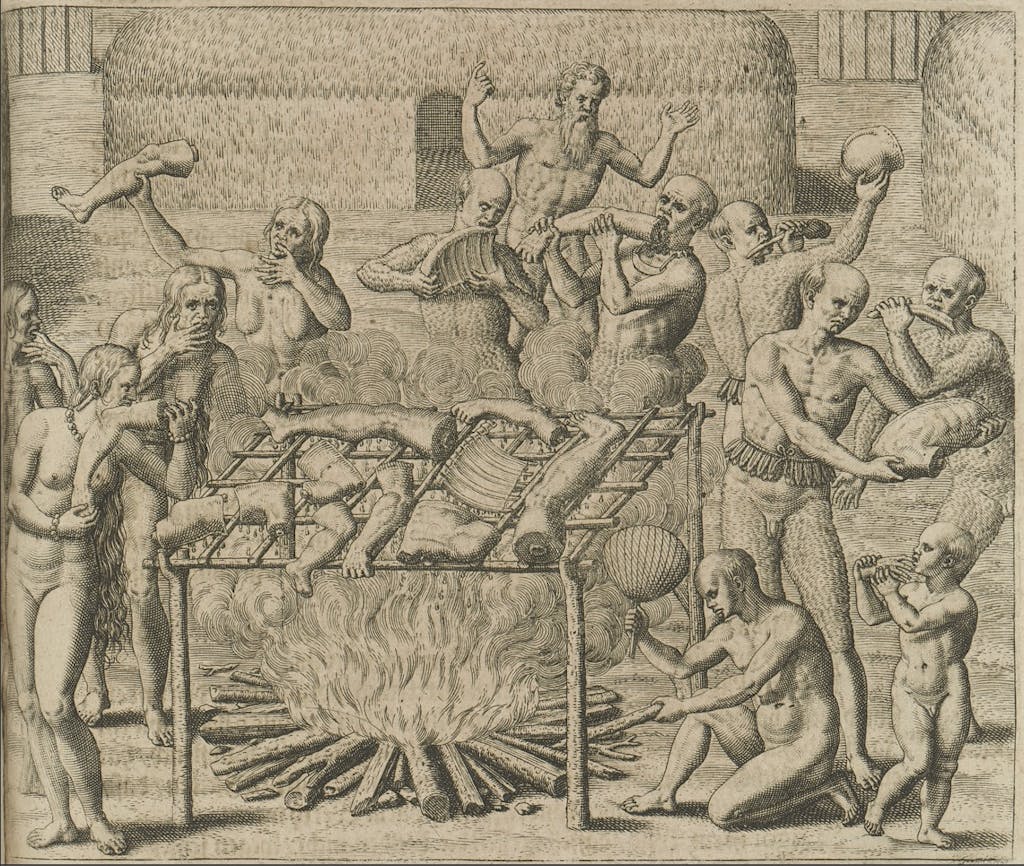In this age of barbecue’s expansion and experimentation we see cuts of meat enter the smoker that have never previously been even figments of barbecue culture. But, there’s one protein that has gone largely ignored in real life, but has a rich history in art and film – human flesh.

Saint Lawrence of Rome is the closest thing we have to a patron saint of pitmasters. He was roasted on a spit in 258 and, as legend goes, just before his death he muttered “Turn me over, I’m done on this side.” It’s doubtful he was eaten, but he was certainly barbecued. Several centuries later in 1593, Theodor de Bry crafted an engraving showing human arms, legs and ribs roasting over a fire. De Bry never crossed the Atlantic, so the accuracy of this particular engraving has been called into question, but it helped shape European views of the barbarism they could expect in the New World.
It is precisely the barbarism in Theodor de Bry’s engraving along with other depictions of cannibalism by the native population here that led author Andrew Warnes to surmise an etymological connection between barbarian and barbecue in his book Savage Barbecue. He argues thusly that barbecue “has yet to escape the fraught implications of savagery and cannibalism inbuilt and original to its name.” Warnes’s hypothesis seems like a convenient stretch that’s required to make some of the outlandish points in his book, but modern filmmakers are working hard to prove his point.
– Trailer for Sacrament
Sacrament is a movie set in Texas and filmed in Texas. It won’t be released until early next year, so I’ve only seen the trailer and a read a few reviews, but the story is a clever one. It uses a religious tent revival in small town Texas as the setting. A group of friends get caught in a storm on their way to South Padre Island. Stuck in the small town of Middle Spring “the smell of barbecue fills the air” as director Shawn Ewert describes in a recent interview. That barbecue will keep the revivalists fed throughout the weekend, and with the film’s tagline “Sinners 4 Dinner,” I think you can guess what is being smoked.
A couple members of the Sacrament cast are horror film veterans including Marilyn Burns and Ed Guinn who both appeared in another movie that was set and filmed in Texas – the original version of The Texas Chainsaw Massacre. Back in 1974, the level of violence portrayed in The Texas Chainsaw Massacre was relatively new to moviegoers, and it’s still pretty grotesque to watch today. If you need to be reminded, humans are harvested by a family of out-of-work butchers in a secluded house in Central Texas. Victims are hung alive on meat hooks, butchered, then frozen for consumption. In the film’s famous dinner scene, Sally Hardesty (played by Marilyn Burns) is brought to the dinner table to share a meal with the demented family. Barbecued portions of her friends make up the menu along. Leatherface must have also had some sausage making skills as evidenced by the links served on the plate.
– The dinner scene in the The Texas Chainsaw Massacre
Many have tried to read into the real theme or meaning of the film. Decades after its release, writer and director Tobe Hooper cleared things up in a 2010 interview with Bizarre magazine. When asked if the film was vegetarian propaganda, Hooper said “I gave up meat while making that film. In a way I thought the heart of the film was about meat; it’s about the chain of life and killing sentient beings…” Even PETA agrees. A compilation of clips by Rob Ager of Collative Learning makes a pretty strong case for this. There are no pigs on the Leatherface property, yet every time someone is about to be killed you hear the grunting and squealing of pigs dubbed along with their screams.
– The Texas Chainsaw Massacre as Vegetarian Propoganda
The target of The Texas Chainsaw Massacre was real horror, so the Butthole Surfers took their music video spoof of the movie to a comedically profane level. In their Entering Texas Bar-B-Que Movie, a family traveling through Texas stops for lunch when they see a homemade sign for barbecue. Against all good judgement, they stop and are greeted by a host of odd characters. Before they realize it, their son Jimmy, disappears. The barbecue is soon served, but it’s Jimmy that is lunch. As the film closes, the two parents are trapped in cages (it was filmed at the old Coxville Zoo in north Austin), and will presumably be on tomorrow’s menu.
– The Butthole Surfers in Entering Texas Bar-B-Que Movie
Back at the Leatherface house, the final dinner scene is disturbing, but it might be creepier when they feed Grandpa earlier in the movie. He is wheelchair bound, so the family carries him down to the dinner table along with a bound-and-gagged Sally. There they cut her finger so Grandpa can suck the blood for a liquid snack. Blood also plays a key role in the barbecue recipes of pitmaster J. T. in the movie Planet Terror. He owns the fictitious Bone Shack barbecue joint (which was housed in the real Zedler Mill in Luling, Texas) where he’s constantly tweaking his sauce recipe. He’s just not happy with it until a little of his own blood accidentally gets into the mix. This is a bit of art imitating life if you remember the case of the Ottis Elwood Toole. He confessed to the killing of Adam Walsh, and also kept a secret barbecue sauce recipe with him that included a cup of blood.
J. T. finding his secret sauce ingredient in Planet Terror
Planet Terror goes so over the top with violence that I laughed more often than I gasped. Another more famous film even goes so far as to make cannibalism into a feel-good part of the story line. Fried Green Tomatoes is the only movie discussed here with no ties to Texas, but barbecue is an important character throughout the film.
Two young white girls, Ruth and Idgie open the Whistle Stop Café in rural Alabama. An African American man named Big George is their accomplished pitmaster. In the early scenes of the movie we see Big George cooking pork butts and spare ribs over a direct heat pit out back. When an investigator from Georgia comes to town to investigate a missing person they stop at the Whistle Stop to question Ruth. She is the ex-wife of the missing man, Frank. The local sheriff can’t help with the investigation, but he does offer that the Whistle Stop has “the best damn barbecue in the state of Alabama.”
The Georgia investigator keeps coming up empty, but continues to visit the Whistle Stop for lunch. The viewer understands that there’s been some foul play in the disappearance of Frank, and because Frank is a low-life wife beater the audience is meant to root against the investigator. The investigator is the out of town villain, so it’s almost expected that there will be some gotcha moment where he is sent off unceremoniously. It could not have been a worse good-bye. In one of the final scenes we learn that Sipsey, a Whistle Stop waitress, was the one who killed Frank with a frying pan. She then colluded with Big George on a plan to dispose of the body by barbecuing it.
Eating Frank in Fried Green Tomatoes
We as viewers should be horrified when we realize the plan, which is revealed with subtlety. First a regular comes to the back door to ask for barbecue. Sipsey replies “oh, not today, you don’t.” She then go to the investigator’s table to clear his plate when he exclaims “why, this is the best barbecue I ever ate!” Sipsey’s sing-song reply is simply “the secrets in the sauce” without a hint of nervousness. Idgie’s expression goes from anxious to relieved, as she overhears the exchange. (I couldn’t track down the clip, but the video above shows the investigator’s fourth helping of barbecued Frank.) The audience is left with the same feeling of relief and even giddiness. My lack of uneasiness was startling when I stopped to think that an otherwise innocent man had just unknowingly consumed another human while just doing his job, and I was chuckling. Maybe Hollywood has corrupted us all, so just be careful not to let barbecue life imitate barbecue art.








